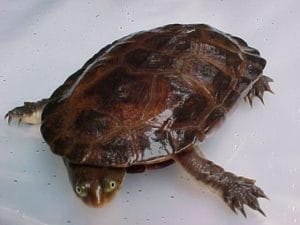Hydromedusa tectifera (Argentine Snake-necked Turtle)
Home > Turtle Database > Hydromedusa tectifera (Argentine Snake-necked Turtle)
The Hydromedusa tectifera, commonly known as the Argentine Snake-necked Turtle, is a distinctive freshwater turtle species native to South America. Recognized for its elongated neck and unique shell structure, this turtle inhabits various aquatic environments and plays a vital role in its native ecosystems.
Native To These Regions
Argentina, Rio Grande do Sul (Brazil), UruguayNative Turtle Species Map – Find Turtles by Region
Scientific Classification
- Kingdom: Animalia
- Phylum: Chordata
- Class: Reptilia
- Order: Testudines
- Family: Chelidae
- Genus: Hydromedusa
- Species: Hydromedusa tectifera
Common Names
- Argentine Snake-necked Turtle
- South American Snake-necked Turtle
- Tectifera Snake-necked Turtle
This Hilarious Turtle Book Might Know Your Pet Better Than You Do
Let’s be real—most turtle care guides feel like reading a textbook written by a sleep-deprived zookeeper.
This one’s not that.
Told from the snarky point of view of a grumpy, judgmental turtle, 21 Turtle Truths You’ll Never Read in a Care Guide is packed with sarcasm, sass, and surprisingly useful insights.
And hey—you don’t have to commit to the whole thing just yet.
Grab 2 free truths from the ebook and get a taste of what your turtle really thinks about your setup, your food choices, and that weird plastic palm tree.
It’s funny, it’s honest, and if you’ve ever owned a turtle who glares at you like you’re the problem—you’ll feel seen.
Identification
Description
The Hydromedusa tectifera is a medium-sized turtle characterized by a long, snake-like neck that can extend up to 60% of its carapace length. The carapace is usually dark brown or olive-green with a slightly keeled surface, while the plastron (underside) is lighter in color. Their limbs are sturdy with webbed feet, adapted for an aquatic lifestyle.
Sexual Dimorphism
Males typically have longer, thicker tails and may be slightly smaller in overall body size compared to females. Females generally have shorter tails and a broader carapace to accommodate egg-laying.
Check more turtles from the Hydromedusa genus
Native Origin and Distribution
Geographical Range
This species is native to South America, primarily found in:
- Argentina
- Uruguay
- Paraguay
- Southern Brazil
Preferred Habitat
Hydromedusa tectifera thrives in slow-moving freshwater bodies such as ponds, swamps, marshes, and streams with abundant aquatic vegetation. They prefer soft, muddy bottoms and often inhabit areas with ample basking sites like fallen logs or rocks.
Behavior
Feeding Habits
Carnivorous by nature, their diet mainly consists of:
- Small fish
- Amphibians
- Crustaceans
- Aquatic invertebrates
They use their elongated necks to strike quickly at prey.
Predators
Natural predators include:
- Birds of prey
- Larger reptiles
- Mammals that may prey on eggs and hatchlings
Reproduction
Breeding Season
Breeding typically occurs during the warmer months, from late spring to early summer.
Reproductive Method
- Oviparous: Females lay eggs in nests dug into sandy or soft soil near water sources.
- Clutch sizes can vary but usually consist of 5-15 eggs.
- Incubation lasts for about 90-120 days, depending on environmental conditions.
Conservation
Extinction Status
- IUCN Red List: Least Concern
Threats
- Habitat Loss: Due to agriculture expansion and urban development.
- Pollution: Contamination of waterways affects their health and food sources.
- Pet Trade: Illegal capture for the exotic pet market.
Conservation Measures
- Protected Areas: Establishment of reserves and national parks.
- Legislation: Enforcement of laws regulating capture and trade.
- Research Programs: Ongoing studies to monitor populations and health.
Economic Importance
- Pet Trade: Occasionally kept as exotic pets, contributing to local economies.
- Ecosystem Impact: Help control populations of aquatic organisms, maintaining ecological balance.
Interesting Facts
- Unlike some turtles, the Hydromedusa tectifera cannot retract its neck vertically into its shell; instead, it folds it sideways under the shell edge.
- They are highly aquatic and rarely leave the water except for basking or nesting.
- Their unique neck adaptation allows them to ambush prey with rapid strikes.

About Author
Muntaseer Rahman started keeping pet turtles back in 2013. He also owns the largest Turtle & Tortoise Facebook community in Bangladesh. These days he is mostly active on Facebook.













